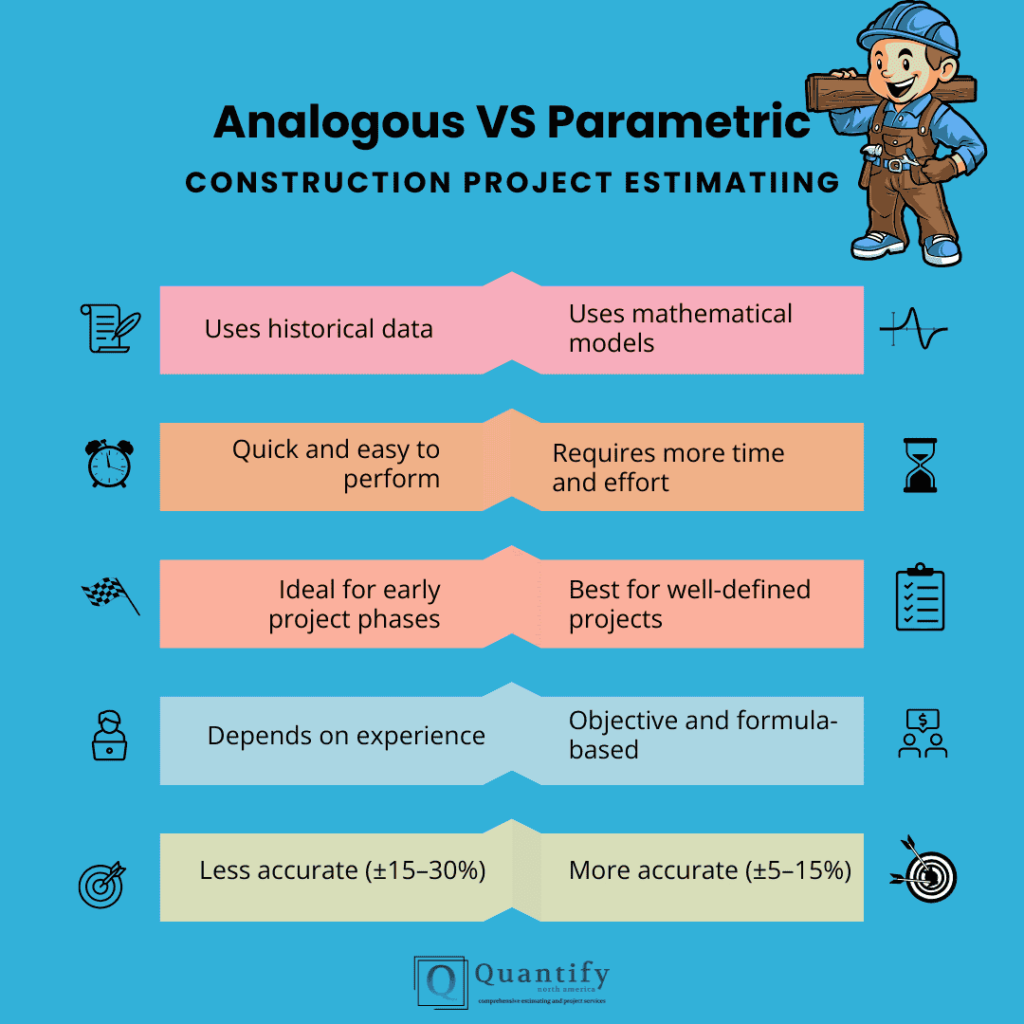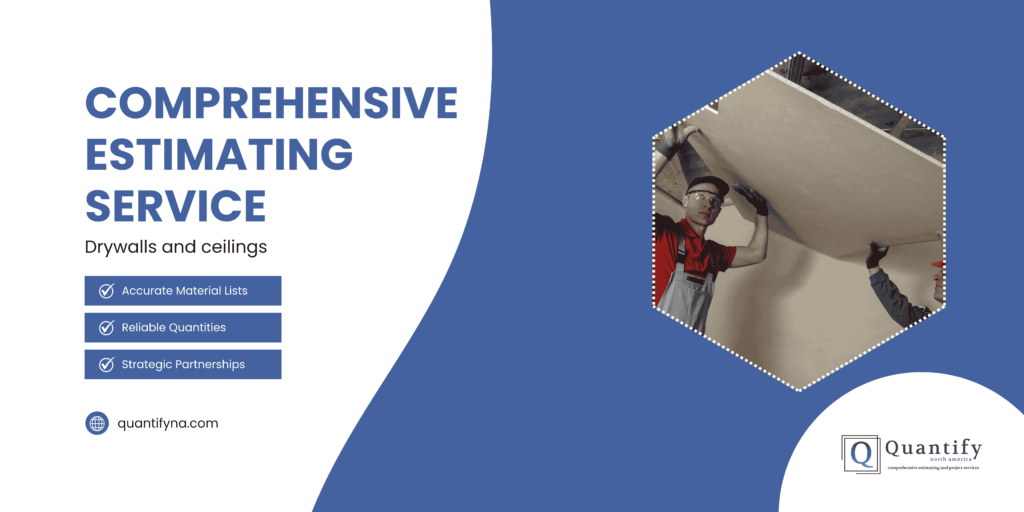Back in the day, it was very easy for contractors to rely almost exclusively on comparing new builds to similar past projects. This approach worked well enough for standard constructions, but error margins increased substantially whenever there were unique requirements.
The difference between analogous vs parametric estimating represents a critical decision point for construction estimators. Both techniques serve as fundamental approaches to project cost prediction, yet they operate in markedly different ways that significantly impact bid accuracy and timeline efficiency.
Mid-sized commercial contractors managing multiple bids across retail, healthcare, and institutional sectors need to know exactly when each method makes the most sense. Applying the right technique at the right time can determine if you win profitable contracts or submit bids that either sacrifice profit or price you beyond consideration.
Understanding Estimating Fundamentals
Before going into the analogous vs parametric estimating comparison, you should have an understanding of construction estimation in a broad sense.
Top-Down vs Bottom-Up Estimating
Construction estimating generally follows one of two paths:
- Top-down estimating: Starting with an overall project figure then gradually breaking it down into smaller components. Both analogous and parametric estimating fall under this category.
- Bottom-up estimating: Starts by identifying all individual tasks, calculating each cost, and then combining it to get the total project cost. This approach typically demands more detailed information but yields greater accuracy.
The decision to use analogous or parametric estimating often depends on the project phase, available data, and required accuracy level.
Analogous Estimating: Building on Experience

Image credit: Freepik
Analogous estimating (also called comparative estimating) uses historical data from completed projects to predict costs for new undertakings. It functions essentially as an informed comparison—applying previous successful project metrics to forecast outcomes for similar new work.
It’s as easy as solving a simple math problem, for example, your company had previously constructed a 50,000-square-foot storage facility for $10 million, you can use that to predict a rough value of $12 million for a new 60,000-square-foot project. This system works particularly well when:
- Projects are in early phases with limited scope definition
- New work closely resembles previous projects
- Quick, preliminary figures are needed for initial budgeting
- Historical project data exists in accessible, usable formats
- Limited time prevents more detailed analysis
Pros of Analogous Estimating
- Quick turnaround: Produces estimates rapidly with minimal information
- Easy comprehension: Simple to understand and explain to clients
- Practical grounding: Based on actual completed projects rather than theoretical models
- Resource efficiency: Requires fewer hours and less detailed analysis
Cons of Analogous Estimating
- Accuracy challenges: Generally less precise than other methods
- Similarity dependence: Struggles with unique or novel construction types
- Subjective influences: Expert judgment affects adjustment percentages
- Time sensitivity: Market conditions change between historical and current projects
Parametric Estimating: The Mathematical Approach

Parametric estimating uses statistical relationships between historical data and variables to calculate project costs. This method breaks down projects into measurable parameters, applies validated cost factors to each parameter, and then combines these calculations to determine total cost.
Rather than simply scaling a previous project cost, parametric estimating might use a validated model showing the cost per square foot of similar facilities in your region, with specific adjustments for mechanical systems complexity, interior finish quality, and site conditions.
Parametric estimating has proven most valuable when:
- Project scope has a reasonable definition
- Statistical data exists for key cost drivers
- Greater accuracy is necessary than analogous methods provide
- Projects contain standardized elements with established cost parameters
- Organizations maintain solid historical data with identified cost relationships
- Teams possess adequate statistical analysis capabilities
Pros of Parametric Estimating
- Enhanced accuracy: Statistical relationships typically produce more precise results
- Better scalability: Adapts to various project sizes more reliably
- Reduced bias: Decreases estimator subjectivity through mathematical relationships
- Stronger justification: Easier to explain and defend to clients
- Consistency: Different estimators using identical parameters achieve similar results
Limitations of Parametric Estimating
- Extensive data needs: Requires substantial historical information and analysis
- Higher complexity: More sophisticated than analogous approaches
- Initial investment: Demands upfront effort to establish valid parameters
- Technical knowledge: The team must understand statistical principles
- Maintenance requirements: Parameters need regular updates to maintain accuracy
Parametric vs Analogous Estimating: Key Differences

When examining parametric vs analogous estimating, several important distinctions emerge that influence which method best fits specific projects:
Accuracy and Precision
Analogous estimating typically achieves accuracy within 15-30% of actual costs. Parametric estimating generally narrows this range to 5-15% when properly implemented. On large to mid-sized commercial projects, this difference can represent hundreds of thousands of dollars.
Information Requirements
This is not a comparison that shows a winner or loser, but more of what to use based on what you have. Analogous estimating requires you to have similar previous projects and basic new project parameters, as well as an expert judgment for adjustments.
On the other hand, using parametric estimating has relatively higher demands. You need to have statistical data on cost relationships, defined scope parameters for new projects, and some mathematical models connecting parameters to costs.
Application Timing
A lot of times, the project timeline dictates method selection. Analogous estimating works well during early conceptual and schematic design phases when details remain limited, while parametric estimating becomes more valuable during design development and early construction document phases after key parameters emerge.
Risk Management Considerations
Each approach carries distinct risk profiles:
Analogous estimating risks include:
- Overreliance on potentially non-comparable projects
- Subjective adjustment factors
- Missing unique project elements
Parametric estimating risks include:
- Invalid statistical relationships
- Outdated cost parameters
- Misapplied mathematical models
Choosing Between Analogous and Parametric Estimating
The selection of analogous or parametric estimating should be deliberate. Consider these factors when deciding:
Project Characteristics
- Uniqueness factor: Highly distinctive projects make analogous methods less reliable
- Size and complexity: Larger, more intricate projects generally benefit from parametric approaches
- Risk tolerance: Lower risk tolerance points toward parametric methods where feasible
Available Resources
- Time constraints: Tight deadlines may necessitate analogous approaches
- Data availability: Robust historical data enables effective parametric estimating
- Team expertise: Staff capabilities affect which method can be properly executed
Recommended Approach by Project Phase
Based on experiences across numerous commercial construction projects:
- Conceptual/Early Planning: Analogous estimating typically proves the most practical
- Schematic Design: Combined approach incorporating elements of both methods
- Design Development: Parametric estimating with increased detail
- Construction Documents: Transition toward detailed bottom-up estimating
Best Practices for Both Estimating Methods
Regardless of your selected approach, these practices enhance estimating effectiveness:
For Analogous Estimating
- Document similarities and differences between reference and current projects
- Apply adjustment factors systematically and transparently
- Use multiple reference projects when feasible to establish upper/lower boundaries
- Review estimates with subject matter experts to validate assumptions
- Record all assumptions for future reference
For Parametric Estimating
- Regularly validate and update cost parameters against completed projects
- Test statistical relationships for relevance in current market conditions
- Document parameter sources and calculation methodologies
- Include appropriate contingency for the project phase
- Continuously refine parameters as project details emerge
Final Decision: Finding the Right Balance

The core difference between analogous vs parametric estimating comes down to balancing speed, available information, required accuracy, and team capabilities. Successful construction firms develop proficiency in both approaches, applying each one appropriately.
Mid-sized commercial contractors facing estimator shortages benefit greatly from understanding when to apply each method to maximize resource efficiency while maintaining estimate quality. Hiring estimating services helps to fast-track this process.
As construction markets continue to evolve amid material volatility and labor challenges, firms that strategically select and skillfully apply the right estimating methods gain competitive advantages through more accurate bids and improved project planning.
So, be it painting, drywall, or flooring estimates, the thoughtful selection between analogous and parametric estimating forms the foundation of successful project delivery.




